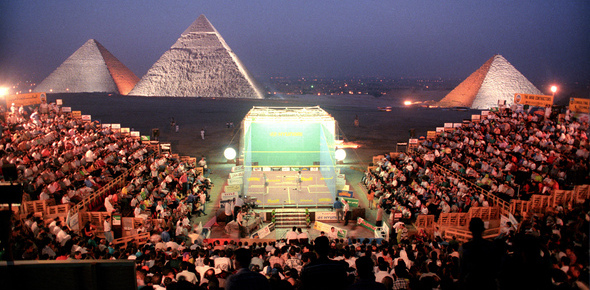A vision for the future- Andrew Shelley
October 15, 2012
Glass is not the new rock and roll. People have been mixing sand with soda and potash for centuries so why have all-glass squash courts only been around for less than thirty years? The answer is that the kick-start was provided by one-way vision. It was the ability to allow spectators to look in but that players couldn’t clearly see out that delayed the opening up of squash to new audiences.
Seeing out too clearly would mean that the players would have difficulty sighting the ball against the glass.
However, in the early 1980’s a patented wall technology called Contra Vision emerged. It was a film, wallpaper if you like, that was applied by self-adhesive film to the inside of the court walls. The trick was that the film was made up of white dots superimposed exactly on to black dots. This configuration meant that viewed from the outside you could see into the court clearly but the players inside looked at a far more opaque surface which acted as a good background against which to sight the ball.
It was this development, akin to one-way glass without the reflection, that linked with the technology of building glass or acrylic walls that took us down the road that has led to the state-of-the-art courts we have now.
During the early years, the walls were white and a normal wood floor used so black balls were used. Then the notion of using coloured dots was tried. That, combined with introducing white squash balls and painting the floors opened up a whole spectrum of colours that can be seen on walls and floors.
Not only that but wallpapering has not required for a number of years as sheets can be baked into the pane so replacing sheets is not needed.
So, we have a colourful presentation. What’s more, with clear panels in the front wall, TV cameramen and still photographers can get shots of the action featuring front views of the players. Spectators too can see the ball hit towards them rather than watching from behind.
And while this was going on the lighting has improved too. Gone are the cumbersome full ceilings, now there are sleek banks of light to illuminate the play.
Add to that the glass floor that has been tried with banks of LED lighting underneath which can light the service boxes, sponsor signs, the score and even just exciting effects and squash has certainly been innovating.
Oh, and I still haven’t mentioned the new ‘side door’ court that allows for an even clearer back wall for broadcast!
So while acrylic and glass were the foundation, it was the cunning little trick of placing dots upon each other that kick-started the development of squash into a genuine spectator sport thirty years ago.
About Andrew Shelley
Andrew Shelley is the Chief Executive of the World Squash Federation.
He has spent eighteen years as Operations Manager for the English Squash body, running the British open and other events, then fifteen years running the Women’s Professional Tour.
{jcomments on}



